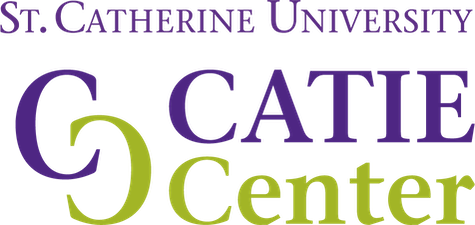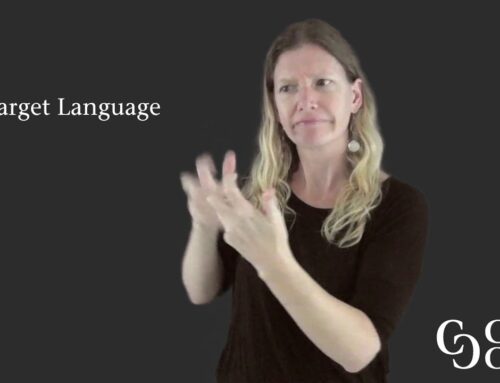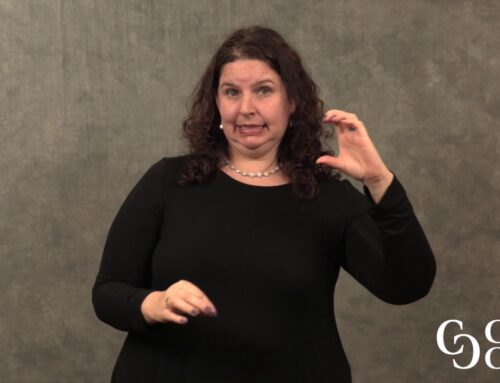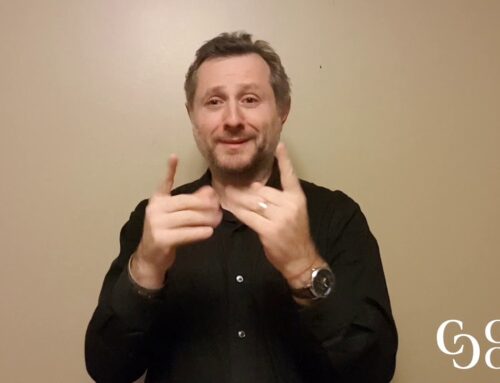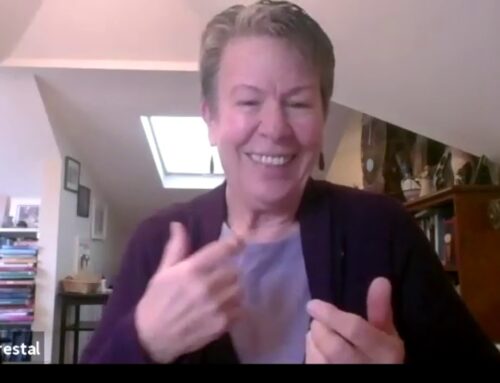Dr. Rachel Herring, a spoken language interpreter and interpreter educator, has a special interest in fostering effective practice for developing interpreting skills. In this 20 minute video, she shares some critical elements to consider when approaching your professional development.
Critical Theme
We want to highlight one theme that comes up in the research, as well as in feedback from 2018 GTC participants. To improve as novice interpreters, we need to practice our interpreting outside of work situations. Just as musicians need to practice for their performance, so too interpreters need to hone their skills when we are not working. We hope that the GTC Resource library will be a useful support for you as you carry out this effective practice.
Visual Description
A white woman with ear-length straight brown hair wearing wire-rimmed glasses and a black shirt stands in front of a mottled grey background. She is primarily positioned on the left half of the screen. A series of slides alternate on the right portion of the video screen.
English Transcript
Good morning! Today we’re here to talk about interpreting and practice. Developing interpreting skill requires practice. This is something we can all agree on. We’ve all heard the mantra “practice practice practice,” but the fact is that not all practice is created equal. When we practice, what we’re trying to do is improve our skills. We’re not just practicing to say that we’ve practiced. So, in this video I’m going to talk to you about getting the most out of your practice. My name is Rachel Herring and I am a spoken language interpreter and also an interpreter educator and trainer. I am here, as I said, to talk to you about practice and how we can get the most out of it.
SLIDE—TIGHTROPE
One of my main areas of interest is understanding how people learn, how we acquire skills, and how we can work to make our learning and practice more effective. What I’d like to talk about is interpreting as a skill to acquire.
SLIDE—SUBSKILLS
The thing we have to understand about interpreting is that it isn’t just one skill. Interpreting involves multiple subskills, all of which have to come together into a whole so that we can do the task. Let’s look a little bit at what happens when we learn a skill.
SLIDE—STAGES IN SKILL ACQUISITION
Skill acquisition happens in stages. The first stage that we go through when we learn a new skill is what we call the cognitive stage. This is when we’re learning how the task is done, what it looks like, how it feels to do it. While we’re in this stage we’re having to think really hard, paying close attention to each of the steps we’re doing or each of the parts of the skill and how we have to do it. After a while move into another stage which is known as the associative stage, in which we start to perform more smoothly. We start to notice errors or ways we can improve our performance, and we start to tweak aspects of how we do things so as to improve. Then we pass into the third stage, which is called the autonomous stage. In this stage we’re able to do the skill, to do the task, more or less without conscious effort for every step. We’re able to do parts of it smoothly without even thinking about it, and our performance becomes more automated. One of the things we have to know about skill acquisition, though, is that it is not a linear process. Sometimes there are plateaus, sometimes there are regressions in which we backslide, sometime we see a leap ahead. It’s important for us to keep this in mind, because when we add a new part of a skill or a new aspect of our performance, sometimes we’ll see that we have increased difficulty with one of the parts of the skill for a period of time until everything starts to integrate and go more smoothly together. This is just a very brief overview of how skill acquisition works.
SLIDE—THE FOREST AND THE TREES
Let’s talk a little bit now about what we know about skill acquisition and interpreters and interpreting. A lot of what we know can be summarized in the saying that we maybe are familiar with of not seeing the forest for the trees, which means that sometimes people can be very lost in the details of a situation and not get the big picture. This indeed is true of novice interpreters. Novice interpreters tend to process information at a more superficial level, focused more on words than on the context or the deeper meaning. They also tend to get lost in details, they might get stuck on things that they don’t know or have trouble with. Basically, one way of thinking about this is that novices have a hard time distinguishing signal from noise—what’s extra from what’s meaningful, or what they need. As we gain skill, though, we gain knowledge, yes, but we don’t just gain knowledge. That knowledge becomes more contextualized, it becomes tied to our prior experiences and to how we understand the world. This allows us to perceive things and to comprehend things more efficiently. The skilled or competent performer is better able to take the measure of a situation, to assess a situation, and figure out what are the things they really need to attend to, what is the most salient part for them. In general, as we acquire skill, as we become more experienced, the better we’re able to see the forest—the big picture—and not get so lost in the trees. However, given that novices are going to get ‘lost in the trees,’ as it were, are going to be having a hard time with integrating all of the things that they have to pay attention to, and deciding what to focus on when, it’s really natural and understandable that novices—that learners—would benefit from having practice that is structured and guided so as to help them direct their attention to the things that they need to work on, either working on little bits of the task or the whole task at once.
SLIDE—INTERPRETING HANDS
When we think about learning interpreting, just like learning any skill, it can be very helpful for us to take the big skill—interpreting—or the big task, and divide it into smaller portions, and focus our energy on working on a specific aspect, a specific piece of what we’re trying to accomplish. It’s easy to overwhelm ourselves, to say “oh, I’m going to work on everything, I’m going to do everything at once,” but that tends not to be as productive as dividing up the task and approaching development of the task in a systematic way. If you think of how athletes or musicians or anyone who is doing a skill practices it, they don’t just generally practice the whole thing. Rather, athletes will practice drills or conditioning exercises; musicians will practice with specific parts of a piece and focus on specific difficulties before putting the whole thing together. It’s good for us, as interpreters, when we’re learning, to think about the different skills that we need to practice and how they fit together—for example, comprehension, or finger spelling, or use of classifiers—and perhaps focus on those separately as we work to put everything together into a big whole. Approaching practice in this way also allows us to identify specific areas of our performance that maybe are causing us problems or that we’re having trouble with, and design practice activities that will allow us to focus on those.
SLIDE—MOUNTAIN CLIMBER
Understanding skill acquisition as a process, as a thing that has steps, is reassuring to us. It can be very reassuring. Many times as learners and sometimes even as educators and trainers we worry about things that are really a normal part of the learning process. We worry about “I didn’t do this well” or “this didn’t go well” or “I’m having trouble with that,” but the fact is that there are some things that we expect from novice performers just because they’re novices, just because they’re learners. That doesn’t mean that they’re incapable, that they’re not good at interpreting, but rather that they’re going through a natural stage in the learning process. Because interpreting involves working with our bodies and our voices and language, it can be very easy to confuse the work we do—our performance as interpreters—with our worth, with who we are as a person and our identity. So, if we approach practicing in a systematic and analytical way that really understands what skill acquisition is and how it works, that can help us to get past the first emotional response and instead focus on how we can work to improve our skills. So, now we come to another question, which is how do we approach practice in a way that is as effective as possible, to get the most of it we can? Because we know that when people are working to improve a skill and working to practice, performance improvement isn’t automatic. People with just with time on task get better to a certain extent, but it’s not the only answer, it’s not the only thing that’s important. How we use the time we spend is equally important. We want to practice in ways that we know tend to be efficient, that will be more likely to lead us to performance improvement in the end.
SLIDE—DELIBERATE PRACTICE
And the kind of practice that we’re talking about here, when we talk about this focused kind of effective practice, is called deliberate practice. It has some special characteristics that I’d like to talk about briefly. One of the first and principal requirements for effective practice or deliberate practice is motivation. We have to want to improve, we have to be motivated to work hard, to try and fail and try again and fail and try again in order to achieve our goals. We have to give ourselves opportunities to stretch ourselves, and opportunities for success as well. Another thing that we have to do is set ourselves well-defined tasks. By tasks here we simply mean practice activities—things we’re going to do. We need to know not just what to do, but why we’re doing it, what is the purpose of the exercise. Setting goals is an important part of this, and we’re going to be talking about that in more detail in just a few minutes. Another thing that we need to be able to do is identify skills that we’re looking for, that we’re looking to develop, in order to work toward our long-term goals. We can systematically say “I need to accomplish this, this, and this in order to get where I’m trying to go” and work on those bit by bit so that we’re systematically working toward the ends that we want to achieve. It’s important to approach practicing with a clear idea of why you’re doing the exercise and where it fits into where you’re trying to get, so that the exercise will be more effective for you and so that you can choose exercises that will lead to your goals. The other thing that’s important to think about in terms of deliberate practice is that it is a cycle. It’s not something that we do once; it’s something that we do over and over again. It involves assessing our performance, our skill; it involves setting goals for ourselves, practicing with difficult or challenging activities, and then going back to the beginning and doing the same thing over and over. We may do this in one single practice session or over the course of weeks or months. In fact, we may even work multiple times with the same material, the same exercise, in order to focus on different aspects of our performance, figure out what we can do to fix problems, and then practice again with the same material to integrate the solutions that we found. Another characteristic of deliberate practice is that it is focused, which is to say, it’s very beneficial to work for short periods of time, focusing very hard, rather than trying to spend a very long time practicing even when we’re mentally exhausted. We need to make sure that we pay attention to our own concentration and our own focus and take breaks when we need them and to really use our time in an efficient way. The last piece that I want to mention is feedback, because feedback is a really fundamental part of deliberate practice. External feedback plays a role—feedback from our instructors, our mentors, the people around us—but self-assessment, self-given feedback is also extremely important. We have to reflect on our work, analyze our work critically, and this of course takes time. It’s not an easy or quick process. It requires us to take the time to review our work, to really analyze it, to see patterns, to take the time to find patterns, to find things that are going well, things that we need to work on and improve, to figure out maybe if we tried a strategy and didn’t work or we realize that one strategy works better than another, and so forth.
SLIDE—PRACTICE CYCLE SLIDE 1
The next thing I’d like to do is talk to you a little bit about what deliberate practice actually looks like. I have an example here of deliberate practice in action. The first thing we want to think about is “What is my goal? What am I trying to achieve?” For example, I might set a goal for this practice session today of effectively rendering high-register ASL into high-register English. I find material. I could go, for example, to the Graduation to Certification website where they allow me to search by different features of the videos they have available. I might find this one that features high-register ASL, as an example. So what am I going to do? Well, I’ll start out brainstorming about this video—what is it about? What do I think I might hear? What do I think is going to be hard for me? Is there something I need to look up or review before I start?
SLIDE—PRACTICE CYCLE SLIDE 2
The next step, now that I’ve brainstormed, is to view the video. I need to pay attention especially to the register of the signers, because that’s what I’ve set as my goal. Then I’m going to record my interpretation into English. But that’s not all—now I need to do some analysis and reflection. For example, I need to listen to my English rendition and I need to assess my work. Now, it’s tempting to think “oh, man, I made… I stood funny, or I made a funny face, or I said strange things in English,” but the goal here was to focus on the register of the source text and convey that in English, so I want to focus my assessment on that goal. Did I successfully do what I was trying to do? The videos on the website have transcripts, translations rather, which are useful as a support when I analyze my work. As I assess my work I can identify things that I think I need to improve. So, maybe I need to find some better English word choices for a specific sign or for a specific ASL construction. Then I’m going to set a new goal that addresses an area of weakness that I identified in my first rendition.
SLIDE—PRACTICE CYCLE SLIDE 3
And then the last step is to bring my deliberate practice cycle full circle. I will maybe view and interpret the video again, and if I set myself a new goal, I’m going to focus on achieving that new goal. I assess my work again, and then identify another goal. Maybe I need to identify the next piece in my skill acquisition trajectory. For example, this was rendering high-register ASL into English consecutively. Maybe another time in the future I want to work on doing the same work, but in simultaneous, to add another level of difficulty, or maybe I want to flip the direction and focus on turning high-register English into high-register ASL. So, this is just an example of a deliberate practice cycle that I hope will be hopeful to you as an illustration.
SLIDE—GOALS
The last thing I want to talk to you about is goals and goal setting, because in my experience setting goals for individual practice, self-directed practice is something that a lot of learners have trouble with. I’m going to end this talk today by talking to you about setting goals for practice and assessing our progress toward our goals.
SLIDE—WHY BOTHER
Why do we even bother with goals? Why have them? Well, the first thing they do is that they focus our attention. Practicing without a goal can be overwhelming. Either we don’t know what to focus on, or there’s so much to focus on that we end up not focusing effectively on anything. One of the things that we know about interpreting practice and interpreting performance is that self-monitoring is important. We need to be able to monitor our own performance, but the fact is that learners can have trouble effectively focusing their attention and effectively self-monitoring because self-monitoring is also a skill that has to develop. Novices, for example, can get overwhelmed by the task. They may not really be able to focus effectively on the aspect of performance that would be most effective for them at that time. We also know that people with different skill levels maybe need to attend to different things. Or maybe we know that we are trying to attend to a specific aspect of performance because someone has told us that we need to, that it’s a weakness, or maybe it’s a new thing that we’re trying to learn to do. Another helpful thing about goals is that they allow us to measure our progress. We can’t say we got better, we can’t measure our progress, unless we’re measuring it against a goal, against an objective. The third thing that I think is very important about goals is they help us to reinforce the cycle of practice—that practice is a cycle. It’s not something we do once, but we go back to it and return to the same skills and increasingly build upon them over time. The second thing that I’d like to comment on here is the idea of who sets goals, where do they come from? They can be set for us by somebody else—an instructor, a coach a mentor, even a textbook. But many times, and especially as we develop more skill and get better at self-monitoring, we set goals for ourselves. We assess our own needs, we find out what we need to do, and we work ourselves on achieving those goals.
SLIDE—GOAL-SETTING
So now I’d like to talk about effective goal setting as part of deliberate practice and the characteristics of the goals we set for ourselves. The first characteristic I’d like to mention is that goals should be specific. As we were talking about a moment ago, our capacity to monitor our own performance is limited, especially when we’re learning a new skill or just starting out, and it’s important for us to make sure that we use that capacity as effectively as possible. We need to set ourselves a specific goal, a specific thing to focus our attention on, as a support to our own self-monitoring. Sometimes we may pick things that are not especially relevant or helpful, or sometimes we may not quite know what we want to focus on, so setting a clear and specific goal before we practice can help direct our attention as we’re performing. When we think about specific we mean, for example… “do a good job,” that’s not specific, that doesn’t tell me what to do. But if I set as my goal “accurately and smoothly fingerspell multi-syllabic proper names,” that’s specific. It tells me what I’m trying to do, and it tells me what I should focus on while I’m practicing. The second characteristic I want to mention is measurable. The goals that we set ourselves should be things that we can tell whether we have met or not. It’s hard to measure our progress over time, it’s hard to see that we’ve achieved things, if our goals are very broad or nebulous. For example, if I say “My goal is to produce a good target language utterance or to produce a good target language string of signing,” that’s not measurable. But if I say “my goal is to produce grammatically correct output in the target language,” that’s something I can measure. The next characteristic I’d like to mention is attainable. Goals need to be attainable. If a goal is too hard, too difficult, it’s demotivating. If the goal is too easy, it doesn’t stretch us. We don’t achieve anything. We want to find goals that work for us where we are right now. They may be part of a bigger, broader goal that we’re achieving over time, but if I’m going to set a goal for practice today or tomorrow, it needs to be something that I can achieve. If I am someone who for example has learned about strategies for clarifying the meaning of a word or a sign that I don’t know and I am wanting to integrate that into my practice, an attainable goal might be “use appropriate strategies to clarify the meaning of a sign or a word that I don’t know.” However, if I’m a beginning level student and I am just learning to use, for example, classifiers, if I set myself the goal of “use appropriate classifiers in a native-like level, like I’m a native signer, while I’m doing simultaneous interpreting,” that goal is probably not achievable today. That goal is probably achievable in some amount of time, but I need to set a goal that works for my current skill level today. Another aspect of goals that we need to think about is that they should be results-oriented, that they should be focused on what will happen, what we will do. Also they need to be time-bound—when will we follow up, when will we accomplish this thing. When are we going to check our progress, whether it’s in this practice session, or we also set goals that are longer term, that we want to accomplish something by next month, next week, next year. Another thing that I am going to talk about in terms of goals and their characteristics is that goals need to be progressive. It’s very easy for us to think about goals as a big long-term thing and say “this time next year I will have accomplished this,” but for deliberate practice, for effective practice, we also need to set smaller goals that are even for today, or this practice session, or the next 15 minutes, and then think about how those goals fit together over time to lead us to those bigger long-term goals that we have. We can think of our goals like pieces of a puzzle—that they need to fit together coherently, they need to build on what we can already do, and increase in difficulty based on the things that we achieve over time.
FULL SCREEN
Thank you very much for listening to my talk today. I hope that this has been helpful to you and that you will be able to apply some of these ideas as you are doing your practice. Bye, and thank you!
Resources & References
If you want to dig deeper into the research related to effective and deliberate practice related to interpreting, here are some resources to explore.
Ericsson, K. Anders. “Expertise in Interpreting: An Expert-Performance Perspective,” Interpreting (Volume 5:2, 2000), 187-220.
EU Interpreters. (2015, July 7). “Interpreters should practice their skill every day – like musicians.” [Video]. Retrieved from https://youtu.be/_RO0m37K1is
Herring, R. E. (2015). A deliberate practice approach to skill improvement. ATA Chronicle, 44(6), 19–23. Retrieved from www.atanet.org/chronicle-online/wp-content/uploads/June20151.pdf
Herring, R. & Swabey, L. (2017). “Experiential learning in interpreter education.” St. Paul, MN: St. Catherine University CATIE Center. Retrieved from: grad2cert.org/experiential-learning-in-interpreter-education
Motta, M. (2011). Facilitating the novice to expert transition in interpreter training: A “deliberate practice” framework proposal. Studia UBB Philologia, 56(1), 27–42. Retrieved from www.studia.ubbcluj.ro/download/pdf/574.pdf
Wink, W. (2012). “ASL talent or deliberate practice?” in Views. (Vol. 29, Issue 1). Alexandria, VA: RID Publications. Retrieved from https://www.winkasl.com/publications/ See ASL version at https://youtu.be/2MtOjBpXIAs
